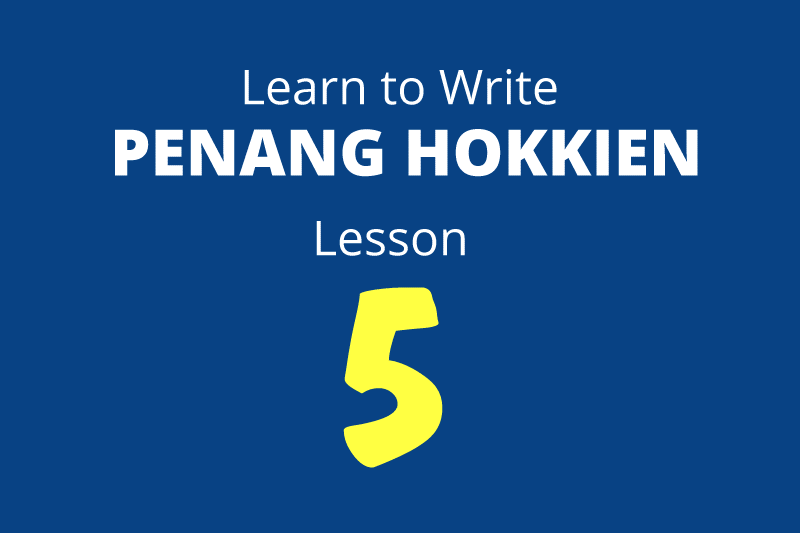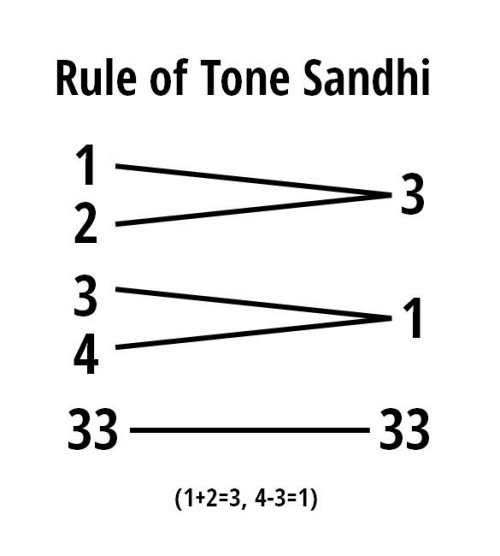
In Lesson 3, we learn that in this new writing system, every syllable carries a tone number, which can be 1, 2, 3, 4 or 33. We also learn that when we combine morphemes, all the morphemes change their tone number except the final morpheme. This is true of all morphemes with tone numbers 1, 2, 3 and 4. Morphemes with tone 33 is unique in that it never changes its tone.
The morphemes change their tone whether they are part of a compound noun (ang1
 + bor4
+ bor4  = ang3bor4
= ang3bor4  ; husband + wife = couple), as an adjective/modifier to a noun (ang2
; husband + wife = couple), as an adjective/modifier to a noun (ang2  + sna1
+ sna1  = ang3 sna1
= ang3 sna1  ; red + shirt = red shirt), as verb (co3
; red + shirt = red shirt), as verb (co3  + kang1
+ kang1  = co1kang1
= co1kang1  ; do + work = do work), and as whole sentences (wah4 + khee3 + thark1 + chaek3 = Wah1 khee1 thark3 chaek3
; do + work = do work), and as whole sentences (wah4 + khee3 + thark1 + chaek3 = Wah1 khee1 thark3 chaek3  ; I + go + read + book = I go to study). Observe that morphemes (and their corresponding words) change their tones if they are originally tone 1, 2, 3 or 4. But if they are originally tone 33, they stay tone 33 (lau33
; I + go + read + book = I go to study). Observe that morphemes (and their corresponding words) change their tones if they are originally tone 1, 2, 3 or 4. But if they are originally tone 33, they stay tone 33 (lau33  + lang2
+ lang2  = lau33 lang2
= lau33 lang2  ; old + man = old man; tua33
; old + man = old man; tua33  + lang2
+ lang2  = tua33lang2
= tua33lang2  ; big + man = adult).
; big + man = adult).The rule for changing the tones is called Tone Sandhi. When a morpheme changes its tone, we say that it sandhis. In a word such as ang3bor4, we say that the morpheme ang1 has sandhied to ang3 to form ang3bor4. The word "ang3bor4" itself, if it's entered into the dictionary, is still regarded as being in the citation tone. If it were used as modifier to another noun, then the final morpheme of that word still sandhis (ang3bor4 + tok3 = ang3bor1 tok3; couples + table = couples table).
But how do the morphemes sandhi? Well, we have seen that ang1
 becomes ang3
becomes ang3  . That means tone 1 becomes tone 3. Now, the good news is that all morphemes which are originally tone 1 will sandhi to tone 3. How about those which are originally tone 2? We saw that ang2
. That means tone 1 becomes tone 3. Now, the good news is that all morphemes which are originally tone 1 will sandhi to tone 3. How about those which are originally tone 2? We saw that ang2  (red) also becomes ang3
(red) also becomes ang3  (in ang3 sna1
(in ang3 sna1  , red shirt). Therefore morphemes of tone 2 also sandhi to tone 3.
, red shirt). Therefore morphemes of tone 2 also sandhi to tone 3.How about morphemes that are originally tone 3 or 4? These sandhi to tone 1. For example, chio3
 + bin33
+ bin33  = chio1bin33
= chio1bin33  (smile + face = smiley face); kang4
(smile + face = smiley face); kang4  + pni1
+ pni1  = kang1pni1
= kang1pni1  (river + side = riverside).
(river + side = riverside).Do you join two morphemes together as one single word, or do you keep them separated? It all depends on your own reasoning. If your intention is to create a compound noun, then write them together as one word, separated only by the tone numbers. But if your purpose is to show an adjective/modifier with a noun, then keep them as two separate words. There is no hard-and-fast rule that you must join or separate, it is up to you the writer to decide. Of course, some words that are commonly regarded as a single entity should be written as one (you don't write ang3mor3tan1
 , rambutan, as ang3mor3 tan1). On the other hand, for the purpose of clarity, you might differentiate ang3mor3du3rian2 or ang3mor3 du3rian2 (soursop) from Ang3mor2-eh3 du3rian2 (the Westerner's durian). Again, as long as clarity is achieved, it is up to the writer whether to join or keep separate (ang3mor3du3rian2 or ang3mor3 du3rian2).
, rambutan, as ang3mor3 tan1). On the other hand, for the purpose of clarity, you might differentiate ang3mor3du3rian2 or ang3mor3 du3rian2 (soursop) from Ang3mor2-eh3 du3rian2 (the Westerner's durian). Again, as long as clarity is achieved, it is up to the writer whether to join or keep separate (ang3mor3du3rian2 or ang3mor3 du3rian2).A good way to remember this rule is 1+2=3, 4-3=1. That means tone 1 and 2 become tone 3, tones 4 and 3 become tone 1. I simplify the rules below.

When you see a word in use within a sentence, and you want to look it up in the dictionary, you have to work backwards. For example, if you see, "Wah1 khee1 co1kang1," assuming you understand the meaning of "wah1" and "co1kang1", but need to look up "khee1", knowing its position within the sentence indicates that it is a verb, you can deduce that the word in citation tone ought to be either khee3 or khee4. Look up khee3 and khee4 to see which of these make sense in that sentence. It is unlikely that both will result in something meaningful. The writing system has a number of built-in disambiguations to avoid ambiguities.
As with all writing systems, it takes a bit of knowledge in order to begin reading intelligibly (similarly, you need some knowledge of English in order to read sentences in English; if you have to look up every single word, your comprehension will be severely checked).
Previous Lesson | Main Page | Next Lesson
Learn Penang Hokkien with Memrise
Now you can use the most user-friendly tool on the web to learn Penang Hokkien. It helps you to listen, understand and memorise. Go to Memrise, and learn Penang Hokkien at your own pace.
Return to Penang Hokkien Resources
Latest from Discover with Timothy: Gurney Bay - what to see and do there
About this website

Hello and thanks for reading this page. My name is Timothy and my hobby is in describing places so that I can share the information with the general public. My website has become the go to site for a lot of people including students, teachers, journalists, etc. whenever they seek information on places, particularly those in Malaysia and Singapore. I have been doing this since 5 January 2003, for over twenty years already. You can read about me at Discover Timothy. By now I have compiled information on thousands of places, mostly in Peninsular Malaysia and Singapore, and I continue to add more almost every day. My goal is to describe every street in every town in Malaysia and Singapore.
Copyright © 2003-2024 Timothy Tye. All Rights Reserved.


 Go Back
Go Back